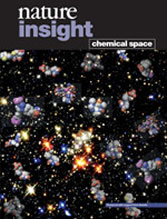"Space", as Douglas Adams famously said "is big. You just won't believe how vastly, hugely, mind-bogglingly big it is". Change 'space' to 'chemical space', and his statement has similar resonance: the total number of possible small organic molecules that populate 'chemical space' has been estimated to exceed 1060 — an amount so vast when compared to the number of such molecules we have made, or indeed could ever hope to make, that it might as well be infinite. So, it is not surprising that our exploration of chemical space has so far been extremely limited.
Taking the analogy further, just as much of astronomical space is a void, much of chemical space contains nothing of biological interest. But rarely, and often through serendipity rather than design, we have identified 'stars' in chemical space — molecules that can modulate biological processes. These molecules have formed much of the basis of our fight against disease and have greatly aided our understanding of biological systems.
But such successful finds have been hard to come by, in part because of our lack of understanding of chemical space. Given that its enormous size makes a thorough exploration of chemical space impossible, a key question is how we should best direct our efforts towards regions of chemical space that are most likely to contain molecules with useful biological activity. This question is a central theme of the articles in this Insight, which were inspired by the Horizon Symposium on 'Charting Chemical Space: Finding New Tools to Explore Biology', the fourth in a series of unique scientific discussion meetings run by Nature Publishing Group and Aventis.
